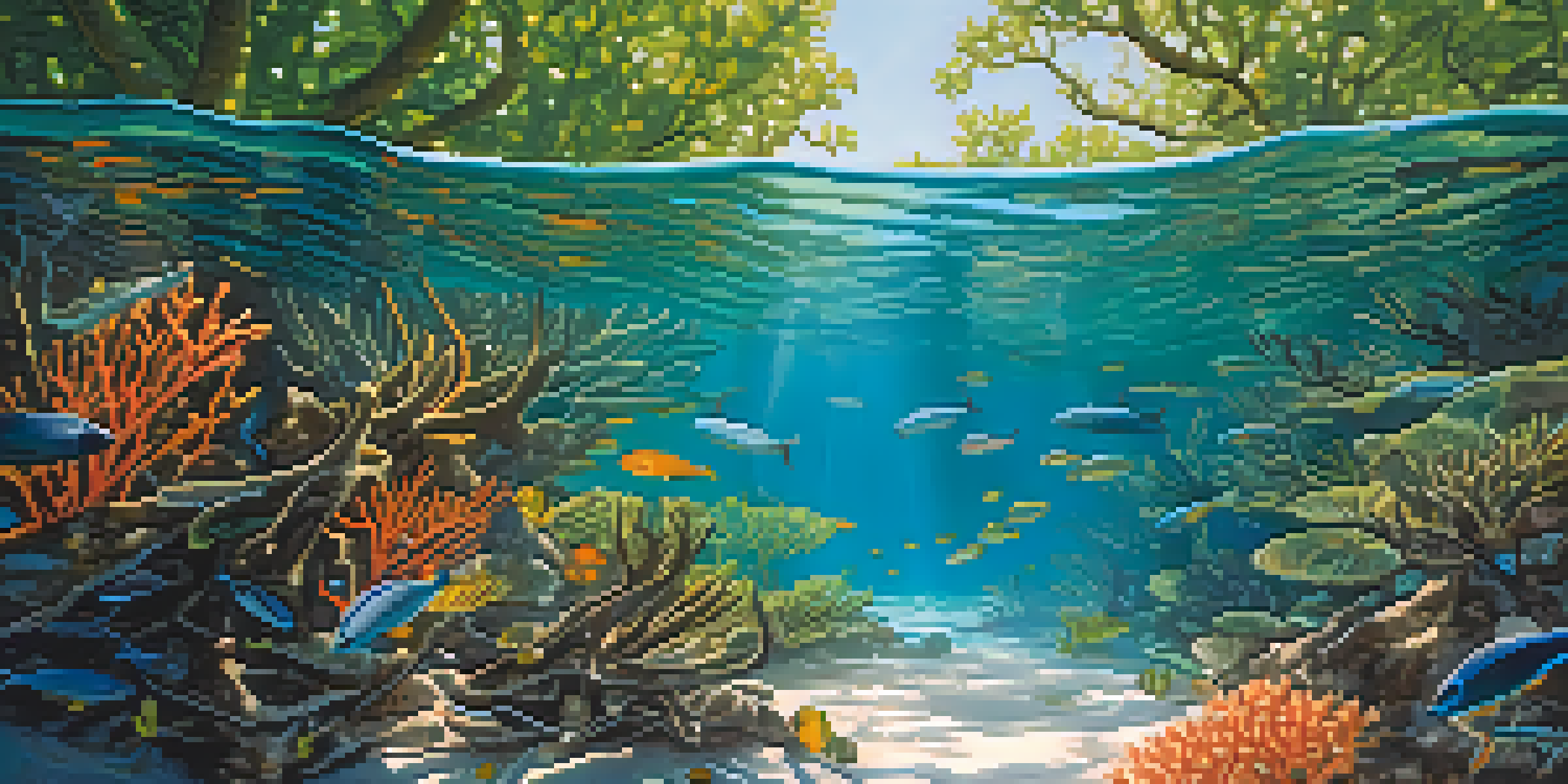Innovative Technologies Supporting Coastal Ecosystem Conservation

Understanding Coastal Ecosystems and Their Importance
Coastal ecosystems, including mangroves, coral reefs, and wetlands, are vital for biodiversity and human well-being. They provide essential services like fisheries, tourism, and natural disaster protection. However, these ecosystems face numerous threats, including climate change and pollution, which jeopardize their health and functionality.
In every walk with nature, one receives far more than he seeks.
The rich biodiversity found in coastal areas supports both terrestrial and marine life, creating a delicate balance that sustains many species. For instance, mangroves serve as nurseries for fish, while coral reefs provide habitats for countless marine organisms. Protecting these ecosystems is crucial not only for wildlife but also for communities relying on their resources.
Innovative technologies are emerging as game-changers in the fight to conserve these precious ecosystems. By harnessing the power of technology, we can monitor, restore, and protect coastal environments more effectively than ever before.
Remote Sensing: Eyes in the Sky for Coastal Monitoring
Remote sensing technology utilizes satellites and drones to gather data about coastal environments from above. This method allows scientists to monitor changes in land use, vegetation health, and water quality over time. For example, satellite imagery can reveal the extent of mangrove deforestation or coral bleaching events, providing valuable insights for conservation efforts.

One of the key benefits of remote sensing is its ability to cover vast areas quickly and efficiently. Traditional monitoring methods can be time-consuming and costly, whereas remote sensing offers a more scalable solution. This means that conservationists can focus their efforts where they are needed most, addressing issues before they escalate.
Coastal Ecosystems Are Vital
Coastal ecosystems like mangroves and coral reefs are essential for biodiversity and provide crucial services such as fisheries and disaster protection.
Additionally, the data collected through remote sensing can be used to inform policy decisions and engage local communities in conservation initiatives. By sharing findings with stakeholders, we can foster a collaborative approach to protecting coastal ecosystems, encouraging sustainable practices that benefit both nature and people.
Artificial Intelligence: Analyzing Data for Better Decisions
Artificial Intelligence (AI) is transforming how we analyze and interpret environmental data. By processing large datasets from various sources, AI algorithms can identify patterns and predict future trends in coastal ecosystems. This capability allows for more informed decision-making in conservation strategies.
The environment is where we all meet; where we all have a mutual interest; it is the one thing all of us share.
For instance, AI can analyze data from sensors that monitor water quality, helping to detect pollution sources or harmful algal blooms much earlier than traditional methods. This proactive approach not only safeguards marine life but also protects the livelihoods of communities dependent on clean water and healthy ecosystems.
Moreover, AI can enhance community engagement by providing easy-to-understand visualizations of complex data. By simplifying information, stakeholders can better grasp the issues at hand and become more involved in conservation efforts, creating a sense of shared responsibility.
Biotechnology: Restoring Ecosystems at a Genetic Level
Biotechnology plays a crucial role in restoring and preserving coastal ecosystems, particularly through genetic interventions. For example, scientists are exploring ways to enhance the resilience of coral species to climate change through selective breeding or genetic modification. These advancements aim to bolster coral populations that are under severe stress from rising ocean temperatures and acidification.
Another exciting application of biotechnology is in the restoration of mangroves and seagrasses. By utilizing tissue culture techniques, researchers can propagate these vital plants more efficiently, accelerating reforestation efforts. Healthy mangrove forests not only sequester carbon but also provide critical habitats for various wildlife species.
Technology Aids Conservation Efforts
Innovative technologies, including remote sensing and AI, enhance our ability to monitor, analyze, and protect coastal environments effectively.
While the ethical implications of biotechnology require careful consideration, its potential to support coastal ecosystem conservation is undeniable. By leveraging genetic tools, we can create more resilient ecosystems that stand a better chance against the challenges posed by climate change and human activity.
Citizen Science: Engaging Communities in Conservation Efforts
Citizen science harnesses the power of local communities to contribute to environmental monitoring and conservation. By involving citizens in data collection and analysis, we can gather valuable information about coastal ecosystems that might otherwise go unnoticed. This grassroots approach not only enhances research but also fosters a deeper connection between people and their natural surroundings.
For example, community members can use mobile apps to report sightings of invasive species or water quality issues, creating a real-time database that informs conservation strategies. When locals are empowered to participate in these efforts, they become more invested in the health of their ecosystems, leading to more sustainable practices.
Moreover, citizen science initiatives can serve as educational tools, raising awareness about the importance of coastal conservation. Workshops and training sessions can equip community members with the knowledge they need to protect their environments, creating a sense of ownership and responsibility for local ecosystems.
Blockchain Technology: Enhancing Transparency in Conservation
Blockchain technology is making waves in various fields, including environmental conservation. By providing a decentralized and transparent ledger, blockchain can help track the funding and implementation of conservation projects. This transparency fosters trust among stakeholders and ensures that resources are being used effectively.
For instance, blockchain can be used to monitor the supply chains of sustainable seafood, preventing illegal fishing practices that threaten coastal ecosystems. By providing consumers with verifiable information about the origin of their seafood, we can promote responsible consumption and encourage sustainable fishing practices.
Community Involvement is Key
Engaging local communities through citizen science fosters a deeper connection to coastal ecosystems and promotes sustainable conservation practices.
Additionally, blockchain can facilitate collaboration between organizations and communities by streamlining data sharing. When all parties have access to the same information, it leads to more coordinated efforts in conservation initiatives, ultimately benefiting the ecosystems we aim to protect.
Innovative Policy Frameworks: Supporting Technology Adoption
To effectively implement these innovative technologies, supportive policy frameworks are essential. Governments and organizations must recognize the value of integrating technology into conservation strategies and create regulations that encourage its adoption. This may include funding for research, incentives for sustainable practices, and partnerships between public and private sectors.
For instance, policies that promote the use of remote sensing and AI in environmental monitoring can enhance the effectiveness of conservation efforts. By establishing clear guidelines and standards, we can ensure that technology is used responsibly and ethically in protecting coastal ecosystems.

Moreover, fostering international collaboration can amplify the impact of these technologies. By sharing knowledge and resources across borders, we can address global challenges such as climate change and biodiversity loss more effectively, creating a unified front in coastal ecosystem conservation.
The Future of Coastal Ecosystem Conservation
As we look to the future, the integration of innovative technologies into coastal ecosystem conservation holds immense promise. From remote sensing to biotechnology, these tools can significantly enhance our ability to protect and restore vital coastal environments. However, successful implementation requires a collaborative approach that involves stakeholders at all levels.
Community engagement, supportive policies, and ethical considerations will play key roles in shaping the future of conservation efforts. By creating a culture of sustainability and responsibility, we can ensure that coastal ecosystems thrive for generations to come.
Ultimately, the fusion of technology and human passion for the environment can lead to transformative change. With the right tools and a collective commitment to conservation, we can safeguard our coastal ecosystems and the myriad benefits they provide.